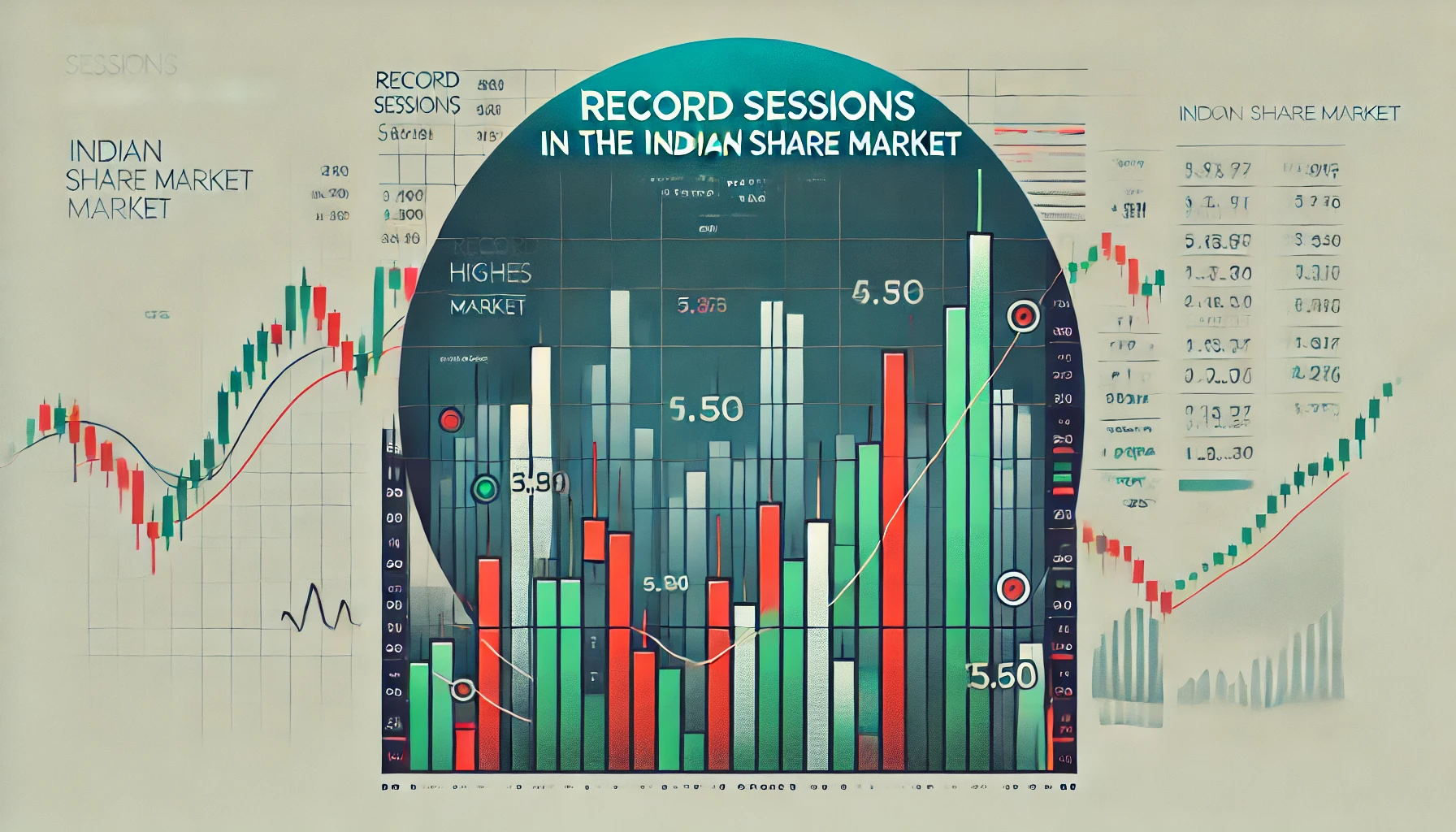Candlestick patterns are one of the most reliable tools in technical analysis, helping traders predict potential market movements based on historical price data. Among these patterns, the Engulfing candlestick pattern is one of the most powerful reversal indicators. In the Indian share market, the Engulfing pattern can signal a shift in market sentiment and provide traders with a clear entry or exit point.
In this comprehensive guide, we will explore the fundamentals of Engulfing candlestick patterns, how to identify them, and how they can be used to enhance your trading strategy. We will also analyze historical data from the Indian share market to show the effectiveness of this pattern in real trading scenarios.
What is an Engulfing Candlestick Pattern?
An Engulfing candlestick pattern occurs when a small candlestick is followed by a larger candlestick that completely engulfs the previous one. This pattern indicates a strong reversal in the market, as the larger candlestick suggests a shift in momentum from one side of the market (bullish or bearish) to the other.
There are two main types of Engulfing patterns:
- Bullish Engulfing Pattern: This pattern occurs after a downtrend and signals a potential bullish reversal. The first candlestick is bearish (red), and the second is a larger bullish (green) candlestick that fully engulfs the previous one.
- Bearish Engulfing Pattern: This pattern occurs after an uptrend and signals a potential bearish reversal. The first candlestick is bullish (green), and the second is a larger bearish (red) candlestick that fully engulfs the previous one.
How to Identify an Engulfing Pattern
To identify an Engulfing pattern, traders look for the following characteristics:
- Bullish Engulfing Pattern:
- Appears after a downtrend.
- The first candlestick is small and bearish.
- The second candlestick is large and bullish, engulfing the entire body of the previous candlestick.
- Bearish Engulfing Pattern:
- Appears after an uptrend.
- The first candlestick is small and bullish.
- The second candlestick is large and bearish, engulfing the entire body of the previous candlestick.
Historical Example of Engulfing Patterns in Indian Stocks
Let’s look at an example of Reliance Industries to see how the Engulfing pattern can be applied in the Indian share market.
| Date | Open | Close | High | Low | Pattern | Signal |
|---|---|---|---|---|---|---|
| 10th March 2023 | ₹2,350 | ₹2,300 | ₹2,400 | ₹2,280 | Bearish Engulfing | Bearish Reversal |
| 18th March 2023 | ₹2,200 | ₹2,250 | ₹2,280 | ₹2,180 | Bullish Engulfing | Bullish Reversal |
In this case, a Bearish Engulfing pattern occurred in early March, signaling a reversal in the uptrend of Reliance stock. A week later, a Bullish Engulfing pattern signaled a reversal in the downtrend.
Using Engulfing Patterns in the Indian Share Market
Engulfing patterns are highly effective in the Indian share market, particularly for identifying potential reversals in stocks, indices like Nifty 50, and even specific sectors such as banking or pharmaceuticals.
Here’s a table showing how the Nifty 50 index reacted to Engulfing patterns during a volatile period:
| Date | Nifty 50 Open | Nifty 50 Close | Pattern | Outcome |
|---|---|---|---|---|
| 1st June 2023 | ₹18,100 | ₹18,300 | Bullish Engulfing | Uptrend continuation |
| 10th June 2023 | ₹18,400 | ₹18,200 | Bearish Engulfing | Downtrend reversal |
In this example, the Nifty 50 index reacted to both Bullish and Bearish Engulfing patterns, with each indicating a reversal in the trend.
How to Use Engulfing Patterns in Your Trading Strategy
Engulfing candlestick patterns can be a key part of your trading strategy, especially when combined with other technical indicators like Moving Averages, RSI (Relative Strength Index), or MACD (Moving Average Convergence Divergence). Here’s how you can incorporate Engulfing patterns into your strategy:
- Trend Reversal Strategy: Look for Engulfing patterns at the top or bottom of a trend. If a Bearish Engulfing pattern appears at the peak of an uptrend, it may signal a reversal. Similarly, a Bullish Engulfing pattern at the bottom of a downtrend signals a potential upward reversal.
- Confirmation with Indicators: Use technical indicators to confirm the signal provided by the Engulfing pattern. For example, a Bullish Engulfing pattern combined with an oversold RSI can give a strong buy signal.
- Entry and Exit Points: When trading Engulfing patterns, wait for the next candlestick to confirm the trend before entering a trade. For Bullish Engulfing patterns, enter a long position after the price moves above the high of the engulfing candlestick. For Bearish Engulfing patterns, enter a short position once the price moves below the low of the engulfing candlestick.
Combining Engulfing Patterns with Other Indicators
Engulfing patterns are even more powerful when used in combination with other technical indicators. Below is an example of how combining Engulfing patterns with the Relative Strength Index (RSI) can enhance trade signals:
| Stock | RSI | Pattern | Signal |
|---|---|---|---|
| HDFC Bank | 30 (Oversold) | Bullish Engulfing | Bullish Reversal |
| Tata Motors | 70 (Overbought) | Bearish Engulfing | Bearish Reversal |
In this table, the combination of an oversold RSI and a Bullish Engulfing pattern in HDFC Bank indicated a strong buy signal, while an overbought RSI and a Bearish Engulfing pattern in Tata Motors suggested a sell.
Benefits of Using Engulfing Candlestick Patterns
- Strong Reversal Indicator: Engulfing patterns provide clear signals of potential trend reversals, allowing traders to capitalize on changes in market sentiment.
- Works Across Timeframes: Engulfing patterns can be used in multiple timeframes, making them suitable for both short-term traders and long-term investors.
- Easily Recognizable: Engulfing patterns are easy to identify on candlestick charts, making them accessible for both novice and experienced traders.
Limitations of Engulfing Patterns
Despite their effectiveness, Engulfing patterns have some limitations:
- False Signals: Engulfing patterns can sometimes provide false signals, especially in choppy or sideways markets where price action is erratic.
- Confirmation Needed: Engulfing patterns are most reliable when confirmed by other technical indicators. Waiting for confirmation before entering a trade is crucial to avoid losses.
Historical Performance of Engulfing Patterns in the Indian Share Market
To assess the effectiveness of Engulfing patterns in the Indian share market, let’s examine their performance during a volatile period such as the COVID-19 crash in March 2020.
| Date | Nifty 50 Open | Nifty 50 Close | Pattern | Outcome |
|---|---|---|---|---|
| 10th March 2020 | ₹10,500 | ₹10,800 | Bullish Engulfing | Market recovery |
| 20th March 2020 | ₹9,000 | ₹8,700 | Bearish Engulfing | Downtrend continuation |
The Bullish Engulfing pattern in early March signaled the start of a short-term recovery, while the Bearish Engulfing pattern later confirmed the continuation of the downward trend.
How to Implement Engulfing Patterns in Your Trading Strategy
If you’re looking to incorporate Engulfing patterns into your trading strategy, here are some actionable steps:
- Look for Engulfing Patterns Near Support or Resistance: Focus on finding Engulfing patterns near key levels where reversals are likely to occur.
- Wait for Confirmation: Always wait for the next candlestick to confirm the reversal before entering a trade. This reduces the risk of false signals.
- Use Technical Indicators: Combine Engulfing patterns with other indicators like Moving Averages, RSI, or MACD to strengthen your signal.
- Backtest Your Strategy: Test your Engulfing pattern strategy using historical data to ensure its effectiveness before applying it in live trading.
Conclusion
The Engulfing candlestick pattern is a powerful tool for identifying potential market reversals in the Indian share market. By recognizing Bullish and Bearish Engulfing patterns and combining them with other technical indicators, traders can improve their chances of making profitable trades. Whether you’re trading stocks, indices, or sectors, mastering the Engulfing pattern will provide you with a valuable edge in the market.

What is the TRIN stock market indicator?
The TRIN (Trading Index), also referred to as the Arms Index, is a technical analysis …

Record Sessions
The Indian share market is a dynamic and volatile space where major highs and lows …

3 Line Strike
Candlestick patterns are a vital tool for traders in the stock market, offering insights into …

3 White Soldiers and 3 Black Crows
Candlestick patterns are a key element of technical analysis in stock trading, offering clear signals …

Gapping Doji
Candlestick patterns are a critical part of technical analysis in the stock market, providing traders …

3 Windows
Candlestick patterns are a vital part of technical analysis, offering traders and investors insights into …

2 Gapping Candles
In the fast-paced world of the Indian stock market, technical analysis plays a crucial role …

3 Inside Down and Up
Candlestick patterns are powerful tools in the world of technical analysis, offering traders insight into …

Bullish and Bearish Belt Hold
Technical analysis is an essential part of trading in the Indian share market. Candlestick patterns, …

Piercing and Dark Cloud Cover
In the ever-evolving Indian stock market, candlestick patterns are crucial for traders aiming to predict …

Double Doji
Candlestick patterns have long been a favored tool for technical traders to forecast market movements. …

Rising and Falling Windows
In the world of technical analysis, candlestick patterns are vital tools for traders to anticipate …

Tweezer Top and Bottom
In the fast-paced world of the Indian share market, traders use technical analysis tools to …

Morning Star and Evening Star
In the Indian share market, technical analysis is a valuable tool for traders aiming to …

Hammer and Hanging Man
The Indian stock market offers a wealth of opportunities for traders who understand technical analysis. …

Shooting Star and Inverted Hammer
The Indian stock market, with its dynamic nature, presents various opportunities for traders and investors. …

Last Engulfing
The Indian share market is filled with patterns that can help traders make informed decisions. …

Harami
In the world of stock market analysis, candlestick patterns offer valuable insights into price movements. …

Engulfing
The Indian share market is known for its volatility, and traders often rely on technical …

Marubozu
Candlestick patterns are powerful tools used by traders in the Indian share market to analyze …

Spinning Top
The Indian share market, like any other, experiences constant fluctuations due to a multitude of …

Doji
The Indian share market is dynamic, with investors using various tools to gauge stock performance. …

Double Top
In the world of technical analysis, chart patterns are valuable tools that help traders spot …

Tweezer
In the Indian share market, where volatility and price fluctuations are part of daily trading, …

Harami
In the world of technical analysis, candlestick patterns are powerful tools that help traders make …

Heiken-Ashi
Navigating the Indian share market can be challenging due to the inherent volatility and market …

Ichimoku
In the world of technical analysis, few indicators offer the comprehensive insights that the Ichimoku …

Value Charts
In the ever-changing landscape of the Indian share market, traders and investors need tools that …

Money Flow Index
In the Indian share market, identifying trends, understanding momentum, and assessing volume are critical components …

Aroon
In the fast-paced world of the Indian share market, identifying market trends and spotting reversals …

Gator Indicator
In the Indian share market, success is largely dependent on identifying the right trends and …



















